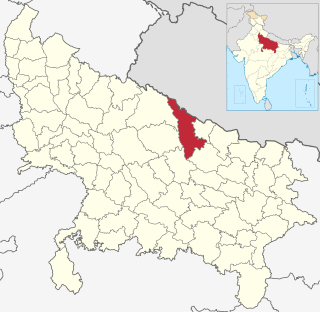Related Research Articles

The wolf, also known as the gray wolf or grey wolf, is a canine native to Eurasia and North America. More than thirty subspecies of Canis lupus have been recognized, including the dog and dingo, though gray wolves, as popularly understood, only comprise naturally-occurring wild subspecies. The wolf is the largest wild extant member of the family Canidae, and is further distinguished from other Canis species by its less pointed ears and muzzle, as well as a shorter torso and a longer tail. The wolf is nonetheless related closely enough to smaller Canis species, such as the coyote and the golden jackal, to produce fertile hybrids with them. The wolf's fur is usually mottled white, brown, gray, and black, although subspecies in the arctic region may be nearly all white.

In folklore, a werewolf, or occasionally lycanthrope, is an individual who can shape-shift into a wolf, or especially in modern film, a therianthropic hybrid wolf-like creature, either purposely or after being placed under a curse or affliction, often a bite or the occasional scratch from another werewolf, with the transformations occurring on the night of a full moon. Early sources for belief in this ability or affliction, called lycanthropy, are Petronius (27–66) and Gervase of Tilbury (1150–1228).

The Big Bad Wolf is a fictional wolf appearing in several cautionary tales, including some of Grimms' Fairy Tales. Versions of this character have appeared in numerous works, and it has become a generic archetype of a menacing predatory antagonist.

Bagheera is a fictional character in Rudyard Kipling's Mowgli stories in The Jungle Book and The Second Jungle Book. He is a black panther who serves as friend, protector and mentor to the "man-cub" Mowgli. The word bagheera is Hindi for panther or leopard, although the root word bagh means any form of panthera and is nowadays mostly used to refer to the Royal Bengal tiger.

Shere Khan is a fictional Bengal tiger in Rudyard Kipling's Jungle Book and its adaptations, in which he is often portrayed as the main antagonist, itself an exaggeration of his role in the original stories, which he only appears in a third of. The name roughly translates as tiger ruler, with shere being the Persian word for 'tiger'), and khan being used as a title of distinction among the Turco-Mongol peoples, usually meaning chief or ruler. According to The Kipling Society, the name "show[s] that he is the chief among tigers". Shere Khan is named after Afghan Emperor Sher Shah Suri.

The striped hyena is a species of hyena native to North and East Africa, the Middle East, the Caucasus, Central Asia, and the Indian subcontinent. It is the only extant species in the genus Hyaena. It is listed by the IUCN as near-threatened, as the global population is estimated to be under 10,000 mature individuals which continues to experience deliberate and incidental persecution along with a decrease in its prey base such that it may come close to meeting a continuing decline of 10% over the next three generations.

The Beast of Gévaudan is the historic name associated with a man-eating animal or animals that terrorized the former province of Gévaudan, in the Margeride Mountains of south-central France between 1764 and 1767.

Wolf hunting is the practice of hunting wolves. Wolves are mainly hunted for sport, for their skins, to protect livestock and, in some rare cases, to protect humans. Wolves have been actively hunted since 8,000 to 10,000 years ago, when they first began to pose a threat to livestock of Neolithic human communities. Historically, the hunting of wolves was a huge capital- and manpower-intensive operation. The threat wolves posed to both livestock and people was considered significant enough to warrant the conscription of whole villages under threat of punishment, despite the disruption of economic activities and reduced taxes. The hunting of gray wolves, while originally actively endorsed in many countries, has become a controversial issue across the globe. Most people see it as cruel, unnecessary and based on misconceptions, while proponents argue that it is vital for the conservation of game herds and as pest control.

The Eurasian wolf, also known as the common wolf, is a subspecies of grey wolf native to Europe and Asia. It was once widespread throughout Eurasia prior to the Middle Ages. Aside from an extensive paleontological record, Indo-European languages typically have several words for "wolf", thus attesting to the animal's abundance and cultural significance. It was held in high regard in Baltic, Celtic, Slavic, Turkic, ancient Greek, Roman, Dacian, and Thracian cultures, whilst having an ambivalent reputation in early Germanic cultures.

Wolf attacks are injuries to humans or their property by gray wolves. Their frequency varies with geographical location and historical period, but overall wolf attacks are rare. Wolves today tend to live mostly far from people or have developed the tendency and ability to avoid them. Experts categorize wolf attacks into various types, including rabies-infected, predatory, agonistic, and defensive.
A man-eating animal or man-eater is an individual animal or being that preys on humans as a pattern of hunting behavior. This does not include the scavenging of corpses, a single attack born of opportunity or desperate hunger, or the incidental eating of a human that the animal has killed in self-defense. However, all three cases may habituate an animal to eating human flesh or to attacking humans, and may foster the development of man-eating behavior.
The Wolves of Hazaribagh were a pack of five man-eating Indian wolves which between February and August 1981, killed 13 children aged from 4 to 10 years. Their hunting range was 2.7 square miles around the town of Hazaribagh in the eastern Indian district of Bihar. They were apparently attracted to the area by the town's rubbish dump, where livestock carcasses and bodies from the local mortuary were often buried, and frequently attracted wolves, striped hyenas, golden jackals and pariah dogs.
The Wolves of Ashta were a pack of 6 man-eating Indian wolves which between the last quarter of 1985 to January 1986, killed 17 children in Ashta, Madhya Pradesh, a town in the Sehore district. The pack consisted of two adult males, one adult female, one subadult female and two pups. Initially thought to be a lone animal, the fear caused by the wolves had serious repercussions on the life of the villagers within their hunting range. Farmers became too frightened to leave their huts, leaving crops out of cultivation, and several parents prohibited their children from attending school, for fear that the man-eaters would catch them on the way. So great was their fear, that some village elders doubted the man-eaters were truly wolves at all, but Shaitans. With the exception of the pups, which were adopted by Pardhi tribesmen, all wolves were killed by hunters and forest officials.

Kenton Joel Carnegie was a 22-year-old Canadian geological engineering student from Ontario on a work term from the University of Waterloo who died in a wild animal attack while he was walking near Points North Landing in Saskatchewan, Canada. Waste dumping attracted black bears and timber wolves to the region. According to a trucker who said he met Carnegie in the cafeteria a few days before his death, he had passed around close-range photographs of large wolf pups that had approached him during walks in nearby woods, and been warned by the trucker that such encounters were extremely dangerous. A bush pilot said he warned Carnegie about an incident in which adult wolves had menaced others walking outside the camp, but Carnegie's family said he would not have taken risks if warned. After reviewing evidence, which included wolf tracks left around the body, the finding of a coroner's inquest was that Carnegie had been killed by wolves. If true, this would make his death one of the first verified cases of a fatal wild wolf attack in North America.
The Wolves of Turku were a trio of man-eating wolves which in 1880 and 1881 killed 22 children in Turku, Finland. The average age of the victims of these wolves was 5.9 years. Their depredations caused such concern that the local and national government became involved, calling help from Russian and Lithuanian hunters, as well as the army. The wolves killed their last victim on 18 November 1881. On 12 January 1882, an old female wolf was shot and twelve days later, an adult male was poisoned, putting an end to the attacks. One of the dead wolves was sent to the hunting museum of Riihimäki, the other in the St Olof’s school where they can still be seen today. The third wolf ended up as a doormat and disappeared.

Wolves are sometimes kept as exotic pets, and in some rarer occasions, as working animals. Although closely related to domesticated dogs, wolves do not show the same tractability as dogs in living alongside humans, and generally, a greater amount of effort is required in order to obtain the same amount of reliability. Wolves also need much more space than dogs, about 25 to 40 square kilometres so they can exercise.

Orcas, also known as Killer whales, have appeared in several movies and many documentaries.
The Kirov wolf attacks were a series of man-eating wolf attacks on humans which occurred from 1944–1954 in nine raions (districts) of the 120,800 km2 Kirov Oblast of the Russian Soviet Federative Socialist Republic which resulted in the deaths of 22 children and teenagers between the ages of 3 and 17. In all cases, the attacks occurred in the April to December period, coinciding with the wolf's cubbing season.

The Bahraich wolf attacks were a series of wolf attacks on humans which occurred between March and September 2024 in Bahraich district in the Indian state of Uttar Pradesh. The attacks were suspected to be carried out by a pack of six wolves. In August 2024, the Government of Uttar Pradesh launched Operation Bhediya to capture the wolves. As of 11 September 2024, at least ten people have been killed with more than 30 people injured in the suspected attacks by these wolves. Five of the wolves suspected to be behind the attacks were captured.
References
- ↑ Linnell, John. "Danger From Wolves". Wolf Song of Alaska. Archived from the original on September 29, 2011.
- ↑ Linnell, John D.C. et al. "Is the Fear of Wolves Justified? A Fennoscandian Perspective" Archived 2008-03-07 at the Wayback Machine
- ↑ Norsk institutt for naturforsking, report, pg. 24. "The fear of wolves: A review of wolf attacks on humans" Archived 2020-08-02 at the Wayback Machine
- ↑ IMDb. "The Man-Eating Wolves of Gysinge"